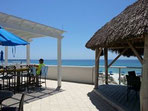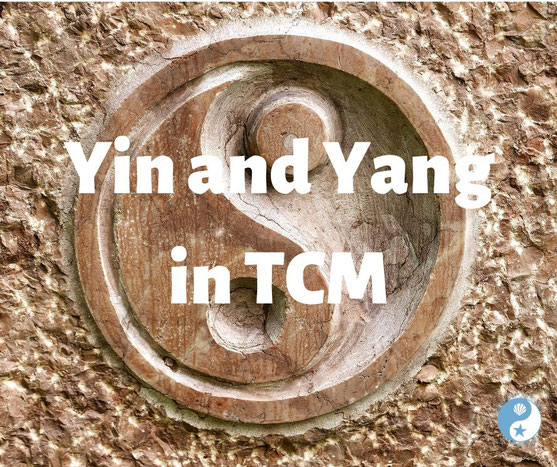
This post contains affiliate links, meaning Beachside Community Acupuncture PLLC may receive a small commission for purchases made through certain links at no additional cost to you. (In other words, you support us in a small way when you buy the products that we highly recommend and would use ourselves!) Click here to view our full disclosure policy.
Most people look at the yin-yang symbol and think, "What a cute reminder to have balance," but Yin and Yang form the basis for Traditional Chinese Medicine (TCM) and epitomize the ancient beliefs of harmony and moderation. Licensed Acupuncturists diagnose their patients in terms of Yin and Yang, and a general knowledge of their characteristics can be helpful in working on wellness between acupuncture treatments.
Yin and Yang Basics
According to TCM, everything in the universe exists in relative amounts of Yin and Yang, and the symbol reflects their four basic properties:
- Opposition: Just as black is the opposite of white, Yin is the opposite of Yang.
- Interdependence: Take away one half of the circle and you will no longer have a circle. Yin doesn't exist without Yang and vice versa.
- Mutual consuming: Following the circle around you'll notice that as the black part becomes larger, the white part shrinks. Yin and Yang are constantly rebalancing in relation to one another.
- Intertransformation: The small dots in the center of the opposite color's largest part represent the fact that even in times of utmost Yin or Yang, there is always the potential for change.
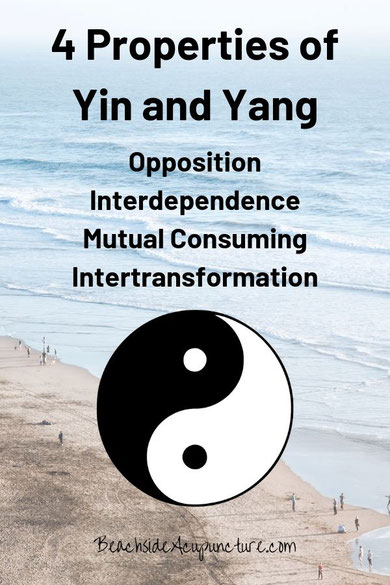
Yin and Yang in Nature
The properties on their own may be difficult to understand, but they really come to life when looking at cycles in nature. For instance, in a 24-hour day:
- The most Yin time would be midnight, midway between when the sun sets and the sun rises.
- As night continues on and dawn approaches, Yin diminishes and starts to transform into Yang, continuing the transformation until noon, which is the most Yang part of the day.
- As the day draws to a close and the sun begins to set, Yin increases again, and the cycle of Yin and Yang repeats.
Following the four properties above, night and day are opposite, you can't have one without the other, they fade into each other cyclically, and they always have the potential to convert.
Another easy example of this constant change and balance in nature is the flow of the seasons. Based on what we discussed so far...
- Which time of the year do you think is the most Yin? If you answered winter, you’re correct!
- What is the most Yang time of the year? That would be summer.
- Autumn and spring are the transition periods between the times of utmost Yin and utmost Yang.
Expounding on Yin and Yang in Nature
Yin and Yang are not just confined to time. Everything in the universe can be sorted as either Yin or Yang, keeping in mind that the distinction is relative. You already know that Yin is dark and Yang is light based on the yin-yang symbol, but what about the other elements of the days and seasons?
- How would you classify rest and activity, two opposites that we experience every day? It makes sense that rest is more Yin because we tend to rest during the night and during the winter – both of which are Yin times – and are more active during the day and summer.
- How about hot and cold? Again, think of summer and winter: The most Yang time of the year is also the hottest, so the fact that heat is Yang and cold is Yin is very logical as well.
Even More Examples of Yin and yang
Yin and Yang go beyond just daily and seasonal cycles. Here are a few more examples to drive the point home:
- The concepts of male and female are tied to Yin and Yang. While our culture has almost eradicated all stereotypes between men and women, in ancient times, women tended to the home and men went out and worked. Another way of looking at it is that women rested with and nurtured the children – even though we all know taking care of kids isn’t usually restful – while men needed to be active at their jobs. Tying this back to our previous example, Yin is more female and Yang is more male. (Classifying men and women this way isn’t meant to be a comment on gender roles; we just think looking at the foundational logic makes these easier to remember.)
- Liquid and gas or vapor can be viewed through the lens of Yin and Yang too. Do you remember any elementary physics classes from your childhood? Liquid turns to gas when it gets heated because its particles become more active…making liquid Yin and vapor Yang.
- Inside and outside - or interior and exterior - are also considered Yin and Yang. Where do you tend to be more active? Outside, right? That would make outside more Yang and inside more Yin.
You may have noticed the terms “more Yin” and “more Yang” instead of simply “Yin” or “Yang” because everything is relative. For instance, your muscles are more Yin than your skin because they are located farther within you. In comparing your muscles to your internal organs, however, the muscles would be more Yang because the organs are deeper inside.
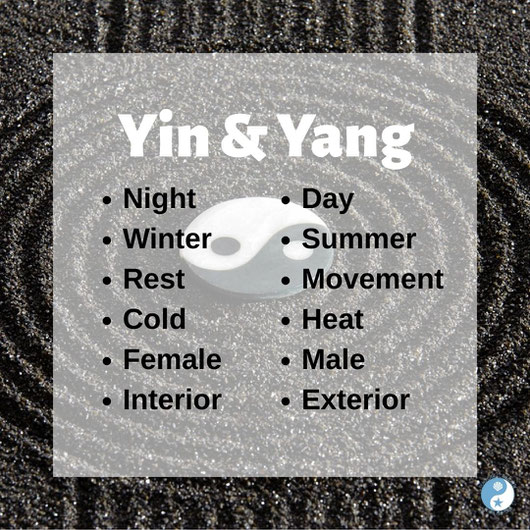
Yin and Yang in Health
With this general knowledge about Yin and Yang and how they relate to each other, we can now look at how they affect health. In the case of our bodies, we’ll generalize Yin as rest, moisture, and coolness and Yang as activity, energy, and heat. Ideally, we would have a balance of both, each flowing with the Yin and Yang of the day as we cool down and rest at night and become active and energetic after waking. However, that’s not often the case. Lifestyle, diet, and other factors can generate an excess or deficiency in either.
Yang Excess
Too much Yang is easy to visualize as too much heat. The most obvious is a person battling a full-on fever, hot to the touch with an elevated temperature. A Yang excess doesn’t have to be that intense, though, and even someone who tends to run hot day to day can have this imbalance. Someone like this may also have an issue with excessive sweating ore even tending to be red in the face.
Yin Excess
Conversely, someone suffering from an excess of Yin may run cold all the time. Yin also ties into moisture and fluid, so edema or swelling can present here as well. Even if someone doesn’t feel swollen, he might feel a heaviness in his body. When fluid condenses even more, it can turn into phlegm, which is another Yin pathology.
Yang Deficiency
Yang deficiency is the state of having not enough Yang, which leads to a relative feeling of cold. Another way of saying this is "deficient Yang producing cold" or just "deficient cold". This may seem very similar to Yin excess, but here the amount of Yin is normal. The signs and symptoms only present as Yin because there's not enough Yang to balance them.
Someone with Yang deficiency will tend to run cold and feel fatigued, as Yang correlates to heat and energy in the body. That can be day-to-day energy, but can also apply to specific physiological activities, for instance sex. A Yang-deficient person can therefore have issues with sexual drive or function.
Just like too much Yin produced excess fluid, not enough moving energy in the body can produce edema in that the normal amount of Yin can’t be moved where it needs to go. Deficient Yang can also lead to symptoms like urinary dribbling and loose stool because the body doesn’t have the energy to hold things in.
Yin Deficiency
In Yin deficiency, or "deficient Yin producing heat" or "deficient heat," a person usually won’t feel hot all the time like in the case of a Yang excess, but rather will experience flashes of heat. She may also feel hot at night – remember night is the time when Yin should dominate but here it can’t because there’s not enough of it – or even experience restlessness at night.
A deficiency of Yin can also lead to unrestrained Yang – again heat and energy and activity – rising to the head, just as heat rises in physics. In this way, Yin deficiency can lead to insomnia, anxiety, high blood pressure, tinnitus, and other conditions.
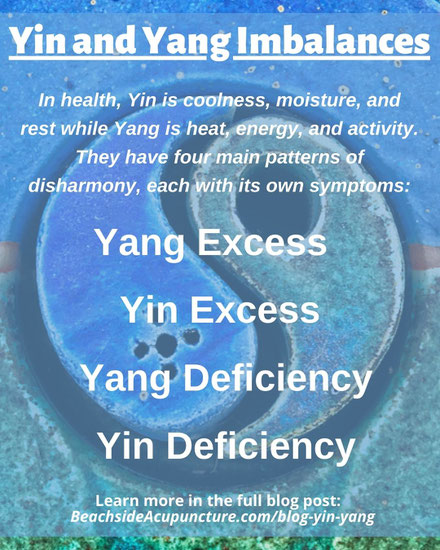
Correcting Yin and Yang Imbalances
A Licensed Acupuncturist would do more to assess a patient's Yin and Yang - many have combination patterns - but if you have the symptoms for one of the patterns above, you can use diet and lifestyle to correct the imbalance.
- Yang excess: limit warming foods, add cooling foods, add bitter foods, limit heat-producing activities (saunas, hot yoga, etc.)
- Yin excess: limit cooling foods, add warming foods, add bland foods, dry brush, exercise, apply heating pads or hot water bottles to the lower back
- Yang deficiency: limit cooling foods, add warming foods, support digestion, do gentle exercise like Tai Chi, apply heat to the lower back
- Yin deficiency: limit warming foods, add cooling foods, drink plenty of water, eat water-rich foods (like soggy oatmeal and soup), limit heat-producing activities
If these adjustments don't give you the relief you need, then it's time to book an acupuncture treatment!
This post was originally published in July of 2019 and was updated in August of 2025.

Kathleen Ketola is a Licensed Acupuncturist and the owner of Beachside Community Acupuncture. She loves providing affordable acupuncture to the residents of McKinney, Texas, and surrounding cities like Prosper, Frisco, and Melissa, but she also enjoys educating the general public on how acupuncture and Traditional Chinese Medicine (TCM) can treat everything from pain to infertility to stress and beyond. Book online or contact her at (214) 417-2260 if you'd like to schedule an appointment.




